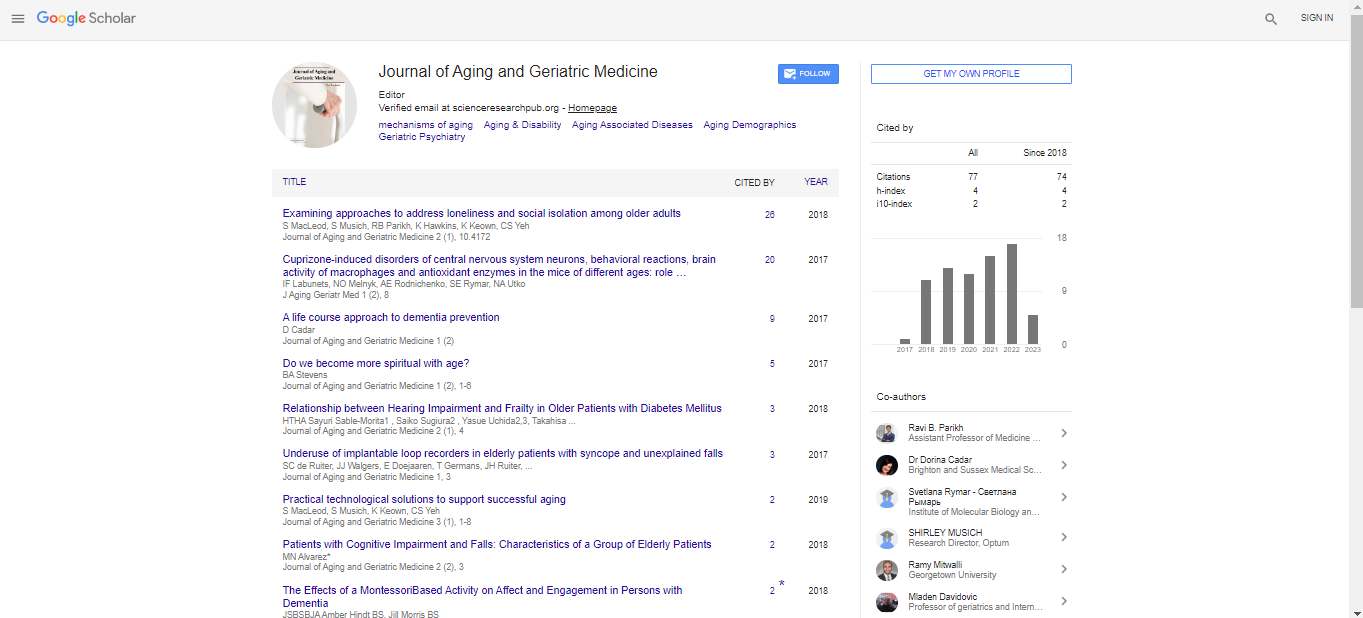Perspective, J Aging Geriatr Med Vol: 7 Issue: 3
Wear and Tear of Cartilage in Aging Joints
Zhuo Van*
1Department of Orthopaedic Surgery, Boston Children's Hospital, Boston, USA
*Corresponding Author: Zhuo Van,
Department of Orthopaedic Surgery, Boston
Children's Hospital, Boston, USA
E-mail: vanzhuo@gmail.com
Received date: 21 April, 2023, Manuscript No. AGM-23-102349;
Editor assigned date: 24 April, 2023, PreQC No. AGM-23-102349 (PQ);
Reviewed date: 15 May, 2023, QC No. AGM-23-102349;
Revised date: 22 May, 2023, Manuscript No. AGM-23-102349 (R);
Published date: 29 May, 2023, DOI: 10.4172/2576-3946.1000161.
Citation: Van Z (2023) Wear and Tear of Cartilage in Aging Joints. J Aging Geriatr Med 7:3.
Abstract
Description
Wear and tear and progressive loss of articular cartilage in older adults are common characteristics of osteoarthritis which is a degenerative joint disease. It is commonly called as osteoarthritis, where the cartilage that covers the ends of bones in joints gradually breaks down and wears away over time. This process is often referred to as the "wear and tear" of the joint.
As individuals age, the cartilage becomes less resilient and less able to repair itself. Factors such as repetitive use, mechanical stress, joint misalignment, and genetic predisposition can further contribute to the degeneration of articular cartilage. Over time the progressive loss of cartilage can lead to joint pain, stiffness, inflammation, and functional limitations.
The wear and tear aspect of osteoarthritis in older adults signifies the cumulative effects of joint use, impact, and aging-related changes on the cartilage. It emphasizes the notion that the joint structures gradually deteriorate over time, resulting in the signs and symptoms of osteoarthritis.
Managing osteoarthritis in older adults typically involves a combination of non-pharmacological interventions, such as exercise, weight management, physical therapy, assistive devices, and pain management strategies. In some cases, surgical interventions, such as joint replacement surgery, may be recommended for severe cases of joint damage and functional impairment.
Important features about osteoarthritis in adults
Osteoarthritis is a common form of arthritis that primarily affects adults, especially those in middle age and older. It is characterized by the progressive degeneration of joint cartilage and the underlying bone, leading to joint pain, stiffness, and functional limitations.
Prevalence: Osteoarthritis is the most prevalent type of arthritis and a leading cause of disability among adults worldwide. It primarily affects weight-bearing joints such as the knees, hips, and spine, as well as the hands and feet.
Risk factors: Several factors increase the risk of developing osteoarthritis in adults. These include age (as the risk increases with advancing age) obesity, joint injury or overuse, family history of osteoarthritis, certain occupations requiring repetitive joint movements, and genetic factors.
Symptoms: Common symptoms of osteoarthritis in adults include joint pain, stiffness (especially after periods of inactivity or rest) reduced range of motion, joint swelling or tenderness, and the formation of bony enlargements or bone spurs around the affected joints.
Diagnosis: Diagnosis of osteoarthritis typically involves a combination of medical history evaluation, physical examination, and imaging tests such as X-rays or Magnetic resonance imaging scans. These help assess joint damage, rule out other conditions, and determine the severity of osteoarthritis.
Treatment: The goal of osteoarthritis treatment is to alleviate pain, improve joint function, and enhance the quality of life. Treatment options may include lifestyle modifications (e.g., exercise, weight management) physical therapy, pain management techniques (e.g., medications, topical treatments) assistive devices (e.g., braces, orthotics) and, in severe cases, joint replacement surgery.
Self-Care and prevention: Adults with osteoarthritis can take steps to manage their condition and reduce its impact. This may involve maintaining a healthy weight, engaging in regular low-impact exercise, protecting joints from excessive stress or injury, using assistive devices or adaptations for daily activities, and following a prescribed treatment plan.
 Spanish
Spanish  Chinese
Chinese  Russian
Russian  German
German  French
French  Japanese
Japanese  Portuguese
Portuguese  Hindi
Hindi 